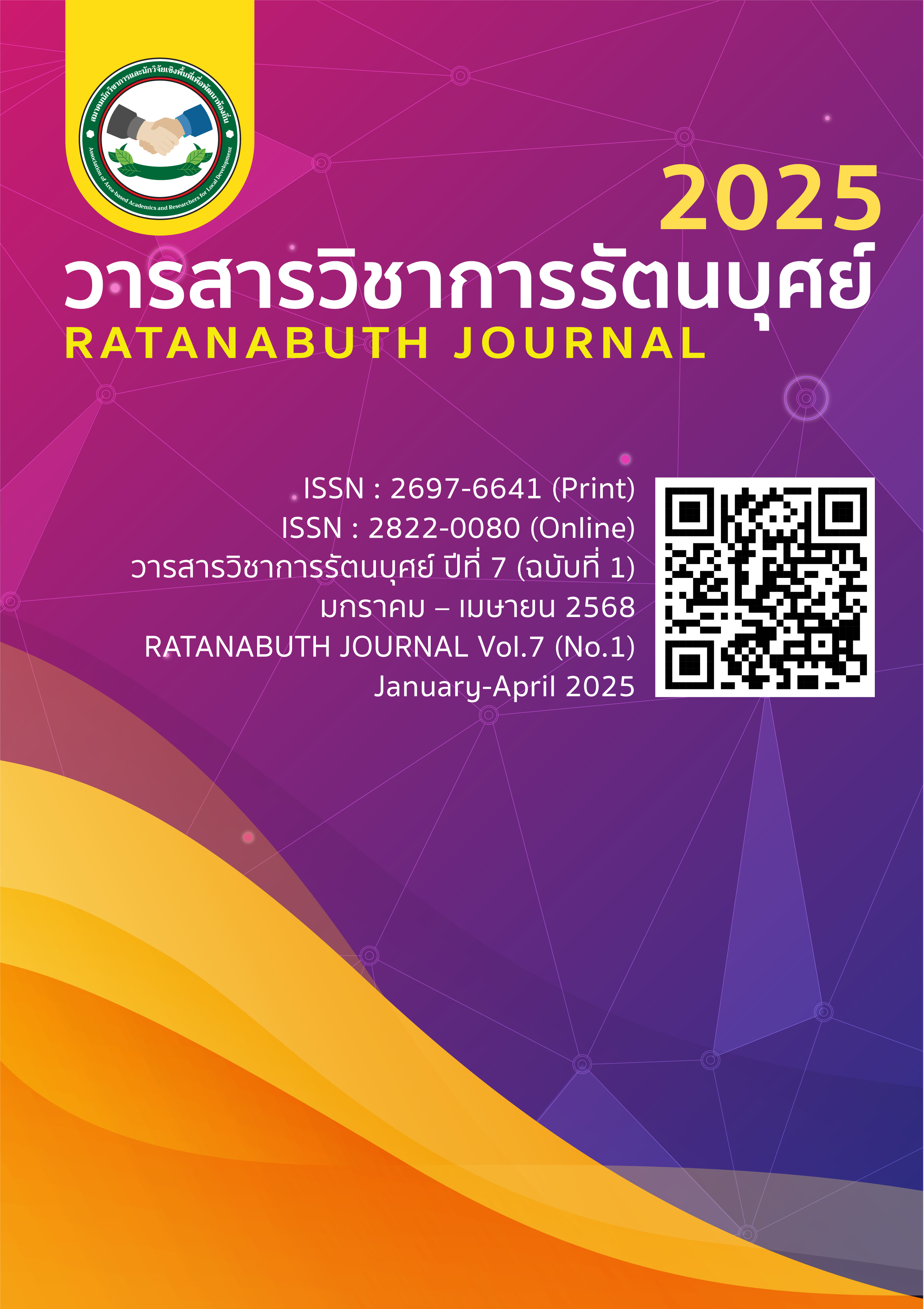ความคิดเห็นเกี่ยวกับการอบรมธรรมของผู้ต้องขังในเรือนจำจังหวัดมหาสารคาม Opinions on the Dhamma training training of prisoners in Maha Sarakham Provincial Prison
Main Article Content
บทคัดย่อ
การอบรมธรรมะในเรือนจำเป็นแนวทางหนึ่งที่ใช้ในการปรับเปลี่ยนพฤติกรรมและจิตใจของผู้ต้องขัง เพื่อส่งเสริมให้เกิดสำนึกในคุณธรรม ศีลธรรม และการดำเนินชีวิตที่ดีขึ้นทั้งระหว่างการถูกคุมขังและภายหลังพ้นโทษ จังหวัดมหาสารคาม การศึกษาวิจัยครั้งนี้ มีวัตถุประสงค์ 1) เพื่อศึกษาระดับความคิดเห็นเกี่ยวกับการอบรมธรรมของผู้ต้องขังในเรือนจำจังหวัดมหาสารคาม 2) เพื่อเปรียบเทียบความคิดเห็นเกี่ยวกับการอบรมธรรมของผู้ต้องขังในเรือนจำจังหวัดมหาสารคาม 3) เพื่อศึกษาข้อเสนอแนะในความคิดเห็นเกี่ยวกับการอบรมธรรมของผู้ต้องขังในเรือนจำจังหวัดมหาสารคาม เป็นงานวิจัยเชิงปริมาณ เครื่องมือในการวิจัย เป็นแบบสอบถาม 5 ระดับ กลุ่มตัวอย่าง ได้แก่ ผู้ต้องขังเรือนจำจังหวัดมหาสารคาม จำนวน 335 คน ได้มาด้วยวิธีการคำนวณตามสูตร ทาโร่ ยามาเน่ กำหนดกลุ่มตัวอย่างตามสัดส่วนและสุ่มอย่างง่าย แล้วนำข้อมูลมาวิเคราะห์โดยใช้สถิติ ได้แก่ ค่าร้อยละ ค่าเฉลี่ย ค่าเบี่ยงเบนมาตรฐาน เปรียบเทียบสมมติฐานใช้การวิเคราะห์ (t – test) และการวิเคราะห์ความแปรปรวน ผลการวิจัย พบว่า 1) ระดับความคิดเห็นเกี่ยวกับการอบรมธรรมของผู้ต้องขังในเรือนจำจังหวัดมหาสารคาม โดยรวมอยู่ในระดับปานกลาง 2) เปรียบเทียบความคิดเห็นเกี่ยวกับการอบรมธรรมของผู้ต้องขังในเรือนจำจังหวัดมหาสารคาม จำแนกตามเพศ อายุ และสถานภาพ โดยรวมแตกต่างกันที่ระดับนัยสำคัญ .05 ส่วนระดับการศึกษา การต้องโทษ และประเภทความผิด โดยรวมมีความคิดเห็นเกี่ยวกับการอบรมธรรมไม่แตกต่างกัน 3) ข้อเสนอแนะการอบรมธรรมของผู้ต้องขังในเรือนจำจังหวัดมหาสารคาม ประกอบด้วย ควรปรับปรุงพื้นที่ที่ใช้ทำกิจกรรม สวดมนต์ไหว้พระตอนเช้าหน้าเสาธงให้ อยู่ในร่ม ควรปรับระยะเวลาที่ใช้ในการสวดมนต์ไหว้พระหน้าเสาธงให้น้อยลง ควรเพิ่มระยะเวลาในการแจ้งประสัมพันธ์กิจกรรมทำบุญตักบาตร ควรเพิ่มระยะเวลาในการแจ้งประสัมพันธ์โครงการอบรมเจริญจิตตภาวนา และควรปรับโครงการฟังเทศนาธรรมจากทุกวันพุธของสัปดาห์ที่ 2 และสัปดาห์ที่ 4 เป็นทุกวันพุธของสัปดาห์
Article Details

อนุญาตภายใต้เงื่อนไข Creative Commons Attribution-NonCommercial-NoDerivatives 4.0 International License.
เอกสารอ้างอิง
กรมราชทัณฑ์ กระทรวงยุติธรรม. (2559). การอบรมธรรมในเรือนจำ. กรุงเทพฯ: กรมราชทัณฑ์ กระทรวง ยุติธรรม.
จรันดร์ ติ๊บอุ๊ด. (2563). การฝึกตนตามหลักธรรมพระพุทธศาสนาของผู้ต้องขังในเรือนจำกลางลำปาง. วารสาร วิทยาลัยสงฆ์นครลำปาง, 8(2), 20–25.
บุญชม ศรีสะอาด. (2558). การวิจัยเบื้องต้น (พิมพ์ครั้งที่ 9). กรุงเทพฯ: สุริยาสาส์น.
รังสรรค์ สิงหเลิศ. (2558). ระเบียบวิธีวิจัยและการใช้สถิติสำหรับการวิจัยทางสังคมศาสตร์. กรุงเทพฯ: ทริป เพิ้ล กรุ๊ป.
เรือนจำจังหวัดมหาสารคาม. (2566). รายงานประจำปี 2566. มหาสารคาม: เรือนจำจังหวัดมหาสารคาม.
Burnett, R. (2004). To reoffend or not to reoffend? The ambivalence of convicted property offenders. In S. Maruna & R. Immarigeon (Eds.), After crime and punishment: Pathways to offender reintegration (pp. 152–180).
Coyle, A. (2005). A human rights approach to prison management: Handbook for prison staff. International Centre for Prison Studies.
Crouch, B., & McGuire, W. (2008). Prison education and rehabilitation: The impact of educational programs on offender behavior. Journal of Criminal Justice, 36(1), 42–49.
King, P. E., & Boyatzis, C. J. (2004). Exploring adolescent spiritual and religious development: Current and future theoretical and empirical perspectives. Applied Developmental Science, 8(1), 2–6.
Kornfield, J. (1993). The art of forgiveness, lovingkindness, and peace. Bantam Books.
Likert, R. (1967). The method of constructing and attitude scale. In Attitude theory and measurement (pp. 90–95). New York: Wiley & Sons.
McGuire, J. (2008). What works in reducing reoffending: A summary of the evidence. Ministry of Justice, United Kingdom.
Rogers, C. R. (1951). Client-centered therapy: Its current practice, implications, and theory. Houghton Mifflin.
Seligman, M. E. P. (2004). Authentic happiness: Using the new positive psychology to realize your potential for lasting fulfillment. Free Press.
Sutherland, E. H. (1939). Principles of criminology (4th ed.). J.B. Lippincott Company.
Vaillant, G. E. (2002). Aging well: Surprising guideposts to a happier life from the landmark Harvard study of adult development. Little, Brown and Company.
Yamane, T. (1973). Statistics: An introductory analysis (3rd ed.). Harper and Row.


